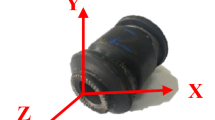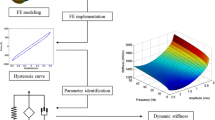Abstract
Due to the nonlinear behavior of rubber for bushings, the prediction of mechanical properties of the bushing requires nonlinear finite element analysis (FEA) techniques and a lot of computation time. Therefore, we propose a method to efficiently predict the stiffness of bushings using an Artificial Neural Network (ANN) model trained by data from FEA. First, FEA was performed for the designed 3D and 2D bushing models. Based on the relationship between the bushing shape design variables and the stiffness values predicted by the FEA, we trained the Multilayer Perceptron (MLP) and the Convolutional Neural Network (CNN) models among the ANN models. Given the shape design variables of the bushing model, the stiffness values were predicted by the MLP model. Given the image of the bushing model, the stiffness values were predicted by the CNN model. The stiffness prediction results showed that both models can be used to predict the stiffness of the bushings, and that the CNN model is slightly more accurate than the MLP model. In particular, it is expected that designers can easily estimate stiffness values by taking advantage of the CNN model which can use photographic images of real parts as inputs.
Similar content being viewed by others
References
Abaqus, V. (2014). 6.14 Documentation. Dassault Systemes Simulia Corporation, 651.
Adkins, J. E. and Gent, A. N. (1954). Load-deflexion relations of rubber bush mountings. British J. Applied Physics 5, 10, 354–358.
Al-Garni, A. Z., Jamal, A., Ahmad, A. M., Al-Garni, A. M. and Tozan, M. (2006). Neural network-based failure rate prediction for De Havilland Dash-8 tires. Engineering Applications of Artificial Intelligence 19, 6, 681–691.
Asteris, P. G., Roussis, P. C. and Douvika, M. G. (2017). Feed-forward neural network prediction of the mechanical properties of sandcrete materials. Sensors, 17, 6, 1344.
Bishop, C. M. (2006). Pattern recognition and machine learning. Springer. New York.
Blundell, M. V. (1998). The influence of rubber bush compliance on vehicle suspension movement. Materials & Design, 19, 1–2, 29–37.
Busfield, J. J. C. and Davies, C. K. L. (2001). Stiffness of simple bonded elastomer bushes. Part 1 — Initial behavior. Plastics, Rubber and Composites 30, 5, 243–257.
Ghaboussi, J., Garrett Jr., J. H. and Wu, X. (1991). Knowledge-based modeling of material behavior with neural networks. J. Engineering Mechanics, 117, 1, 132–153.
Horton, J. M. and Tupholme, G. E. (2006). Approximate radial stiffness of rubber bush mountings. Materials and Design 27, 3, 226–229.
Hyperworks, A. (2018). HyperMesh User’s Manual. Ito, S., Koishikura, T. and Suzuki, D. (2010). Modeling and analysis techniques for suspension rubber bushings. 2010 SIMULIA Customer Conf., Providence, RI, USA.
Kadlowec, J., Gerrard, D. and Pearlman, H. (2009). Coupled axial-torsional behavior of cylindrical elastomer bushings. Polymer Testing, 28, 2, 139–144.
Kadlowec, J., Wineman, A. S. and Hulbert, G., (2003). Elastomer bushing response: experiments and finite element modeling. Acta Mechanica 163, 1–2, 25–38.
Kim, H. Y., Kim, H., Lee, W. I., Kye, K. T. and Lee, W. H. (2003). Static/dynamic analysis and shape design for rubber bush. Proc. Korean Society of Automotive Engineers, 2003 Fall Conf., Busan, Korea, 1633–1638.
Kingma, D. P. and Ba, J. (2014). Adam: A method for stochastic optimization. arXiv preprint arXiv:1412.6980.
LeCun, Y., Bottou, L., Bengio, Y. and Haffner, P. (1998). Gradient-based learning applied to document recognition. Proc. IEEE 86, 11, 2278–2324.
Mansouri, M. R. and Darijani, H. (2014). Constitutive modeling of isotropic hyperelastic materials in an exponential framework using a self-contained approach. Int. J. Solids and Structures 51, 25–26, 4316–4326.
Nair, V. and Hinton, G. E. (2010). Rectified linear units improve restricted boltzmann machines. Proc. 27th Int. Conf. Machine Learning (ICML-10), 807–814.
Rivlin, R. S. (1948). Large elastic deformations of isotropic materials IV. Further developments of the general theory. Philosophical Trans. Royal Society of London. Series A, Mathematical and Physical Sciences 241, 835, 379–397.
Seibert, D. J. and Schöche, N. (2000). Direct comparison of some recent rubber elasticity models. Rubber Chemistry and Technology, 73, 2, 366–384.
Taghavifar, H. and Mardani, A. (2013). Application of artificial neural networks for the prediction of traction performance parameters. J. Saudi Society of Agricultural Sciences 13, 1, 35–43.
Treloar, L. R. G. (1944). Stress-strain data for vulcanized rubber under various types of deformation. Rubber Chemistry and Technology 17, 4, 813–825.
Treloar, L. R. G. (1973). The elasticity and related properties of rubbers. Reports on Progress in Physics 36, 7, 755–826.
Üreyen, M. E. and Gürkan, P. (2008). Comparison of artificial neural network and linear regression models for prediction of ring spun yarn properties. I. Prediction of yarn tensile properties. Fibers and Polymers 9, 1, 87–91.
Vijayabaskar, V., Gupta, R., Chakrabarti, P. P. and Bhowmick, A. K. (2006). Prediction of properties of rubber by using artificial neural networks. J. Applied Polymer Science 100, 3, 2227–2237.
Welch, B. B., Jones, K. and Hobbs, J. (2003). Practical Programming in Tcl/Tk. 4th edn. Prentice Hall Professional. Upper Saddle River, NJ, USA.
Yeoh, O. H. (1993). Some forms of the strain energy function for rubber. Rubber Chemistry and Technology 66, 5, 754–771.
Zeiler, M. D. and Fergus, R. (2014). Visualizing and understanding convolutional networks. European Conf. Computer Vision, Springer, Cham, 818–833.
Acknowledgement
This work was supported by the basic research support program funded by the Ministry of Education of Republic of Korea (NRF-2017R1D1A1B03029350). Also we would like to acknowledge the financial support from the R&D Convergence Program of NST (National Research Council of Science & Technology) of Republic of Korea.
Author information
Authors and Affiliations
Corresponding author
Additional information
Publisher’s Note
Springer Nature remains neutral with regard to jurisdictional claims in published maps and institutional affiliations.
Rights and permissions
About this article
Cite this article
Jung, YW., Kim, HK. Prediction of Nonlinear Stiffness of Automotive Bushings by Artificial Neural Network Models Trained by Data from Finite Element Analysis. Int.J Automot. Technol. 21, 1539–1551 (2020). https://doi.org/10.1007/s12239-020-0145-1
Received:
Revised:
Accepted:
Published:
Issue Date:
DOI: https://doi.org/10.1007/s12239-020-0145-1




